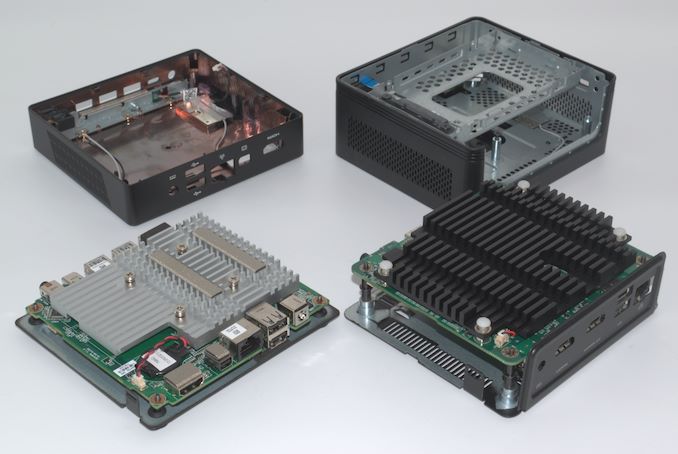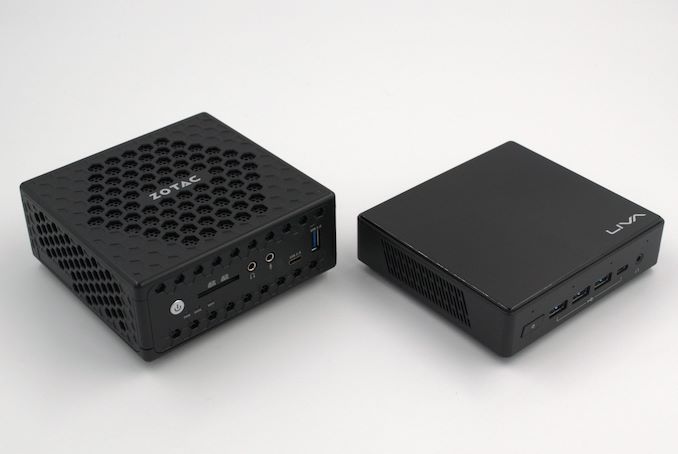Jasper Lake Fanless Showdown: ECS LIVA Z3 and ZOTAC ZBOX CI331 nano UCFF PCs Review
by Ganesh T S on July 8, 2022 8:30 AM EST- Posted in
- Systems
- ZOTAC
- Fanless
- ECS
- Passive Cooling
- UCFF
- Mini-PC
- Jasper Lake
Concluding Remarks
The PC market had been waiting expectantly for systems based on Jasper Lake, given the time elapsed since the introduction of Gemini Lake products. The ECS LIVA Z3 and ZOTAC ZBOX CI331 nano provided us with the opportunity to evaluate Jasper Lake in a passively-cooled system. From our evaluation of the Z3's board - JSLM-MINI, it is clear that Jasper Lake can provide admirable performance in a limited power envelop. It is a solid successor to Gemini Lake.
The microarchitectural improvements have led to significant performance increase in many real-world CPU-intensive workloads, particularly evident when the numbers of the JSLM-MINI are compared against those of the LIVA Z2. On the GPU front, the updates are rather modest. While a complete verdict can only be delivered after evaluating actively-cooled systems and performing additional apples-to-apples comparisons, Jasper Lake appears to have delivered the goods it promised.
Unfortunately, the same can't be said for the systems themselves. The ECS LIVA Z3 shoots itself in the foot with an abysmal chassis choice. The ECS LIVA Z2, despite its thickness, possessed a rather effective thermal design. It never throttled in any of the workloads. In moving to the Z3, ECS unfortunately did not pay heed to the old adage of not fixing things that aren't broken. Followers of the ECS LIVA lineup of PCs might have noticed that the LIVA Z3 chassis and the Z2 chassis are very different from each other.

Chassis and Thermal Modules - ECS LIVA Z3 (L) and ECS LIVA Z2 (R)
The LIVA Z2 was roomier and possessed a metal frame along with a slightly larger thermal module. Unfortunately, the LIVA Z3 leaves very little gap between the plastic top and the thermal module. The Z3's chassis is actually the same as that of the LIVA Z3 Plus.
However, the Z3 Plus was an actively cooled system. For some reason, ECS decided to take a chassis meant for an actively cooled board and reuse it for a passively cooled one. The complete lack of support for convective cooling of the thermal module puts a huge dampener on the performance and user experience with the LIVA Z3. The fact that the motherboard / thermal module combination (JSLM-MINI) by itself performs admirably across the board only adds to the disappointment.
We had plenty of back-and-forth with ECS as we processed the review. ECS did give us a look at their thermal chamber evaluation test reports for the system - the workloads processed were Intel's Thermal Analysis Tool and Passmark Software's BurnIn Test for one hour each. Given that our Prime95 + Furmark test triggered throttling around the 85-minute mark (which then carried on over to the AIDA64 SST despite the cool-down period), it is not surprising that ECS's tests didn't catch the problem. The thermal throttling issue has been reported by other reviewers too.
In our opinion, the only way to ensure the ECS LIVA Z3's intended performance would be to have a fan blowing across the ventilation holes on the side of the chassis.
ECS has also opted for an ancient WLAN card - the Wireless-AC 3165 was introduced back in 2014. The RAM supplied with the pre-built configuration is DDR4-2666, while the Jasper Lake platform supports up to DDR4-2933. However, these choices have allowed ECS to price the system quite reasonably. A ready-to-use configuration can be purchased for just $250. This is in complete contrast to the other system reviewed today - the ZOTAC ZBOX CI331 nano's barebones version without RAM or SSD costs around $260.
The thermal design of the ZBOX CI331 nano also left us a bit disappointed. The absence of proper support for cooling the SATA drive is a minor issue. However, the inability of the system to handle a 7W package (when a similarly designed system was able to handle 12W easily back in the Skylake days) warrants further investigation. The saving grace in the proactive throttling is that the system is able to deliver much higher performance for extended durations after recovering from the thermal throttling. This is not an ideal situation, but appears to be better (both from a performance and user-experience perspective) compared to the LIVA Z3.
The pricing of the ECS LIVA Z3 is quite attractive, coming in at $232 in the US market. The ZBOX CI331 nano, on the other hand, is harder to come by, and available on special order ($260), though it should be much easier to find outside North America. Given the performance profile of the two systems, they can be recommended for duties such as thin clients and lightweight browsing.
Workloads involving hardware acceleration (such as video decoding and rendering for digital signage purposes) will also not make the systems sweat. On the business front, point-of-sale terminals and digital kiosks also present workloads that these systems should be comfortable with. Hobbyists and tinkerers might also appreciate them to get an understanding of what makes passively-cooled systems work. Fixing the thermal throttling issues could be an interesting challenge for such folks.











52 Comments
View All Comments
xol - Friday, July 8, 2022 - link
Correction (?)Neither of these reviewed products has a Intel UHD Graphics 605 .. (that's a 14nm Gemini part with 18 EU eg here https://ark.intel.com/content/www/us/en/ark/produc...
.. Intel seems to have not publisher a 'number' for this iGPU and seems to distinguish them by number of EU eg Jasper Lake 24EU eg https://www.intel.co.uk/content/www/uk/en/products...
xol - Friday, July 8, 2022 - link
Somehow messed up the link :UHD 605 https://ark.intel.com/content/www/us/en/ark/produc...
mode_13h - Friday, July 8, 2022 - link
Thanks for your coverage of fanless mini-PCs. However, I really wish you'd include something with "big cores", so we can get a sense of the scale of performance difference between them and Tremont.Another nice-to-have would be at least a few benchmarks including a Raspberry Pi 4. However, it has serious thermal throttling issues, unless it's actively cooled or you use a substantial passive cooling solution.
mode_13h - Friday, July 8, 2022 - link
I guess the ideal comparison would be a Tiger Lake-based system, since that's the same vintage and similar manufacturing tech as Tremont. Probably much harder to find in a fanless mini-PC, unless we're talking about an industrial PC, but I'd love even to see a comparison between two NUCs: Tiger Lake vs. Tremont.mode_13h - Friday, July 8, 2022 - link
Or maybe Ice Lake would be even better, but did they make Ice Lake-based NUCs?abufrejoval - Thursday, July 14, 2022 - link
Yes, Tiger Lake NUCs were made, but also very hard to come by: I have both.In a way they are perfect to showcase the benefit of E/P cores …in the case of Intel: AMD is really another story.
The two NUCs look nearly identical on the outside, but inside they are very different beasts.
For starters: The Tiger Lake NUC11 (i7-1165G7 with 96EU Xe iGPU) is configured with a 64 Watt PL2, a rather long TAU and even the PL2 is 30 Watts by default, I believe. There is a reason it comes with a 90 Watts power brick! I changed PL2 to 50, TAU to 10 seconds and PL1 to 15 Watts to ensure the fan would never howl they way it does with the defaults.
I’ve seen HWinfo report a 5GHz maximum clock, but 4.7GHz is the official top speed. It’s at 64 Watts and near 5GHz clocks that I have measured 1707/5808 Geekbench 4 results on Linux (always a bit faster than on Windows). Jasper Lake doesn’t quite play in the same league at 781/2540 using 3.3 GHz and 10 Watts. In Watts/compute power Tiger Lake looks rather worse than Jasper Lake, but when it comes to rendering a complex web page or recalculating a giant Excel sheet, its sprinting power certainly has it appear much faster.
At 64 Watts the Tiger Lake is a desktop CPU, shoehorned into mobile power envelopes. And when it’s constrained to the levels that passive cooling can manage (see the Supermicro SYS-E100-12T-H review here), it really struggles to deliver that performance. The great thing about the Tiger Lake NUC is that you can change PL1, PL2 and TAU to pretty much anything you want and when you set it to the 10 Watts the Jasper Lake gets to use as an absolute maximum, it starts to do rather badly.
Some of that is because the iGPU always gets preference, leaving close to nothing to the CPU. But some of that is that the remaining power budget forces very low frequencies, where the big Core CPU loses against the Atom cores running at a full speed with these Watts.
Jasper Lake, like all the other Atoms since the J1900, never slows down. I’ve never seen it drop below its “Turbo” clock unless idle, even on a mix of Prime95 and Furmark, and I’ve never seen it exceed 10 Watts of combined CPU+GPU power consumption either.
I also have two Ryzen 5800U based notebooks (1443/7855 on Geekbench4), one of which can be switched between 15 and 28 Watts of TDP. When Tiger Lake and Zen 3 are strictly set to the same power levels, Tiger Lake has to run much slower even with half the cores: Ryzen beats it with a much smaller energy footprint per core. But with Tiger Lake left at the default NUC settings (which a battery powered notebook could not support), its four cores will beat an eight core Zen 3 at 15 Watts in Geekbench, which luckily never seems to exceed TAU.
Intel needs E/P because P cores need too much power at the clock rates they require to beat a Ryzen core, and only with E cores they can hit the efficiency of Zen cores in fully multi-threaded loads.
mode_13h - Thursday, July 14, 2022 - link
Wow, another awesome post! Thanks for taking the time to relate your findings. Very interesting!> the iGPU always gets preference, leaving close to nothing to the CPU.
Very key point, but also one that Intel could conceivably address, to some extent, in future BIOS updates. Not that they're likely to, if it had been on the market for a while when you tested, but it's conceivable.
> in Geekbench, which luckily never seems to exceed TAU.
Another great point! I have never run Geekbench myself, and I haven't noticed reviewers mention this key detail.
Foeketijn - Saturday, September 3, 2022 - link
Don't you want to write for Anand?stanleyipkiss - Friday, July 8, 2022 - link
Zotac makes a fanless zbox with a 1165G7xol - Friday, July 8, 2022 - link
Benches I've seen suggest both are very similar in multi to a i3 low power Skylake eg a ie-6100T (2core 4 thread very common thin client chip) - the gfx capability also seems also a close match for the 24EU part [probably a very similar part with improved HEVC support] (the 32EU N6000 should be better)For single threaded the old Skylake is ~+50% faster., and from Skylake to Alder Lake it's nearly 2x , so nearly 3x from N5100 to i5-12500 for single thread
I have an old fanless Atom Z3735F (22nm) and these new SoCs are a impressive step up (~7x both cpu and gpu) -- I think the Pi Model B latest is very roughly 2x better than that nut no where near the 5100T in any metric.
tldr both benches would have been a wash one way of the other.